Suji ki Puri for golgappa or pani puri or puchka with step by step photos. These puri made with semolina, all purpose flour dough are light and crisp. Perfect to carry the various delicious pani puri fillings. Make a big batch of these suji ke golgappe and store it in an airtight container to make your favorite pani puri or puchka.
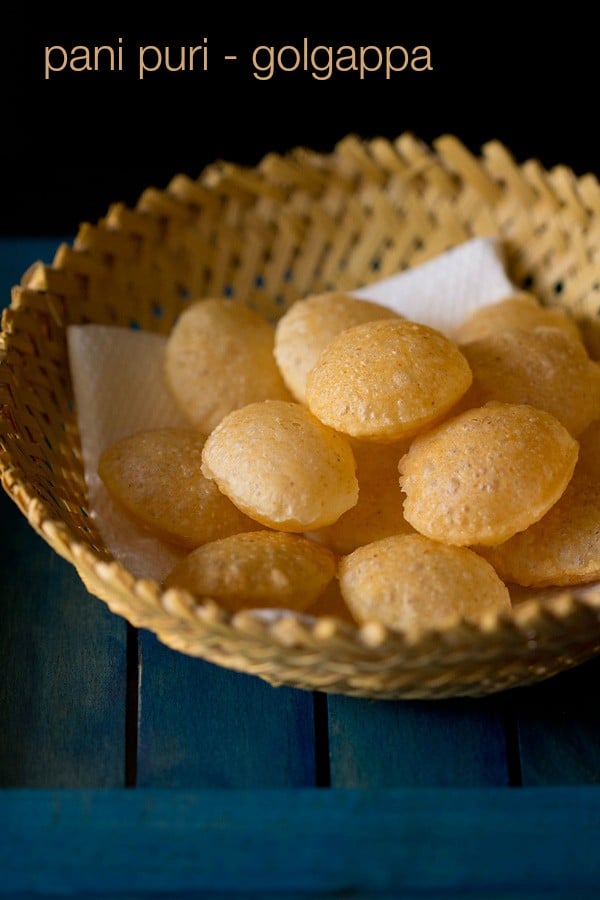
Pani Puri, as I call this awesome snack has always been a favorite since childhood. I remember me and my folks having pani poori from the pani puri wallah on the streets of Mumbai many times.
I have even seen how the puris are made in bulk and then sold. While as a kid, I used to think, how come the puri puffs so much and stays crisp. There was a family, close to my house who used to make these puris in bulk, pack them and then supply them to grocery stores.
We are fond of these crisp puris, that most of the times we just have them plain. I have made these pooris many times. Hence, I have updated this post with better photos and a lot of tips.
I was getting many comments that the pani puri becomes soft after cooling down. when I make them, I never had this issue. I reasoned, that this problem is because the dough was not kneaded well and the poori roundels being thick.
Previously I has just mentioned to knead the dough well. But not emphasized that the dough also need to have elasticity in it. Hence updated this suji ke golgappe recipe post.
I must say its easier to get a packet of ready made puris than to make them. Its does take an effort to make these pooris. So prepare them, when you are free from any work.
The perks of making homemade suji ke golgappe are that fresh oil and ingredients are used. Plus no additives or preservatives are added and you know what goes into them. Also they do taste better than the store brought ones.
These puris can be made in large numbers and stored in an airtight container. This recipe yields 50 to 60 pooris. However you can easily halve or double the recipe.
You could use these suji ke golgappe later to make Pani Puri or Golgappa or ragda puri or puchka or Dahi Puri, just crumble and top it up on Ragda Patties, dahi papdi chaat, aloo chana chaat, sev puri, bhel puri or just have it plain.
How to make Suji ke Golgappe
Make the Suji (Semolina) Dough
1. In a mixing bowl, take 1 cup fine unroasted sooji or rava or semolina (160 grams), 1 teaspoon oil, 3 to 4 pinches of baking soda and ¼ teaspoon salt.
Remember to use fine textured rava. You can also use bombay rava. It should be in the shelf period and not be infested with insects or molds.
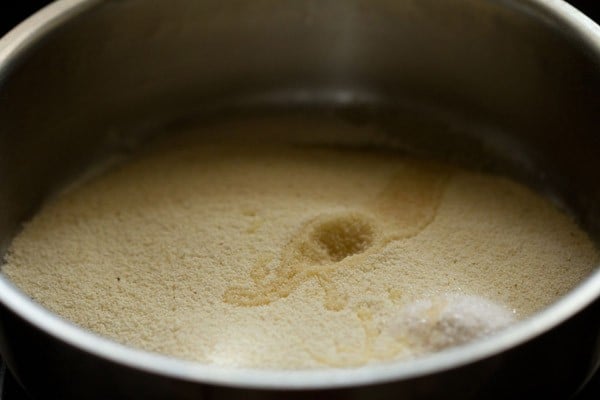
2. With your fingers, mix the oil evenly with the sooji.
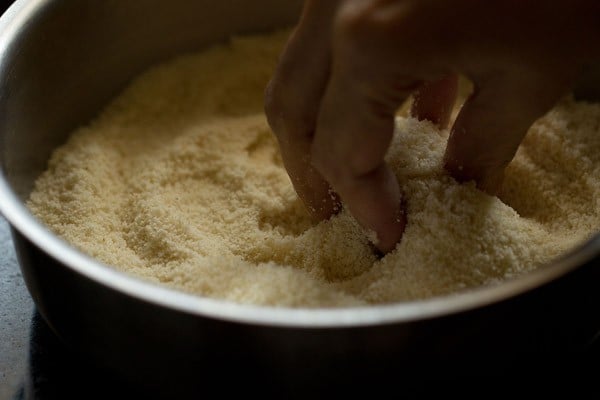
3. Here’s the evenly mixed oil, sooji and salt mixture.
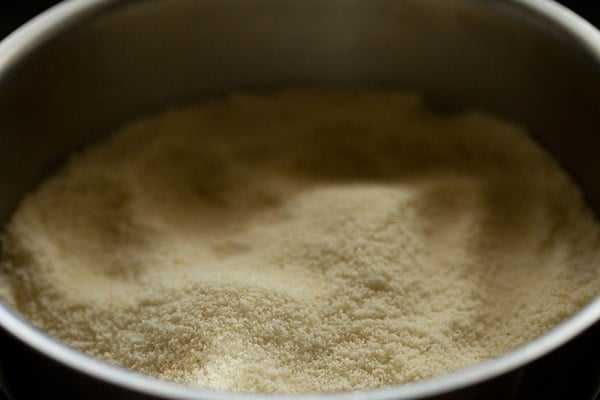
4. Now add 1 tablespoon maida (all purpose flour) to this mixture.
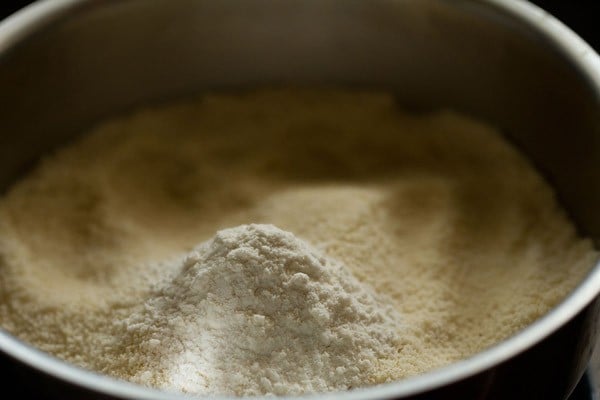
5. Mix again very well so that the all purpose flour is mixed evenly.
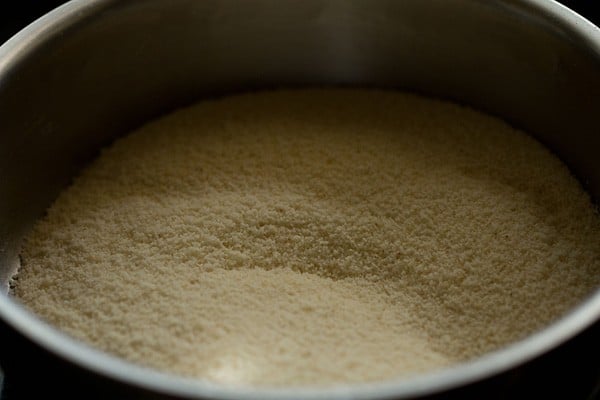
6. Add 3 tablespoons of water first.
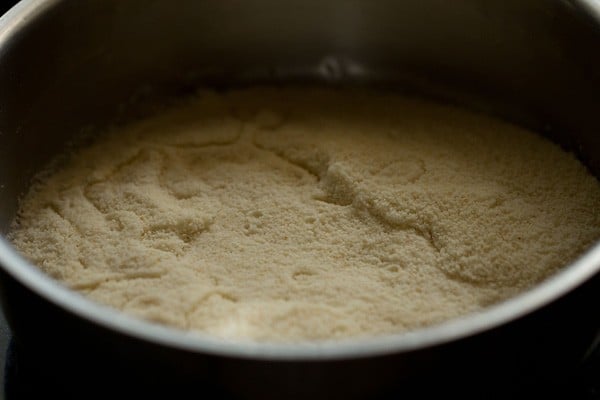
7. Stir and mix again.
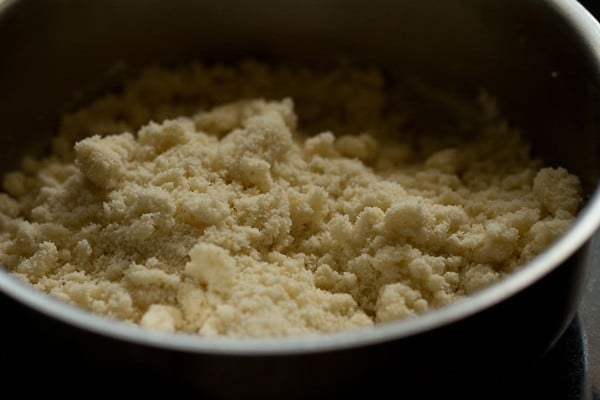
7. Then add 1 tablespoon water more and begin to knead the dough. Sooji absorbs water while kneading. Hence add water in parts while kneading. Then add 2 tablespoons more of the water and continue to knead. I added 6 tablespoons of water.
Depending on the quality of sooji, you may need to add a bit less or more. The kneading is very important in getting the perfect pani poori texture.
Remember that the dough is not soft nor too hard. If you make the dough soft, then add 1 to 3 teaspoon more of the sooji. If the dough looks hard, then add sprinkle some water and continue to knead.
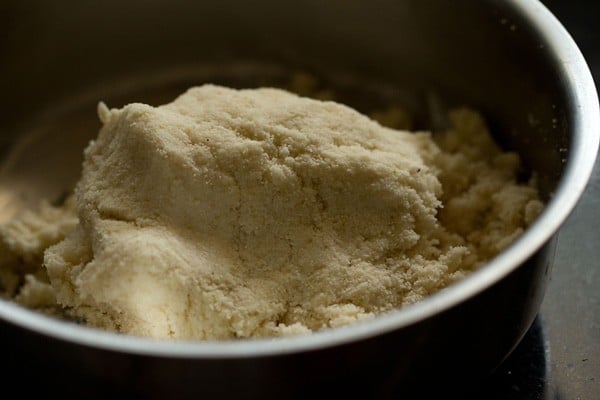
8. The puri dough should be elastic. Gluten strands need to be formed, which gives structure and shape to the pooris.
The correct texture of the dough, also help in puffing pooris and helps in them staying crisp. So knead very well.
Elasticity helps in the rolling dough without cracks and thinly. When rolling, the dough should roll easily without any cracks.
You should be easily able to lift the rolled dough without it tearing or breaking and falling apart.
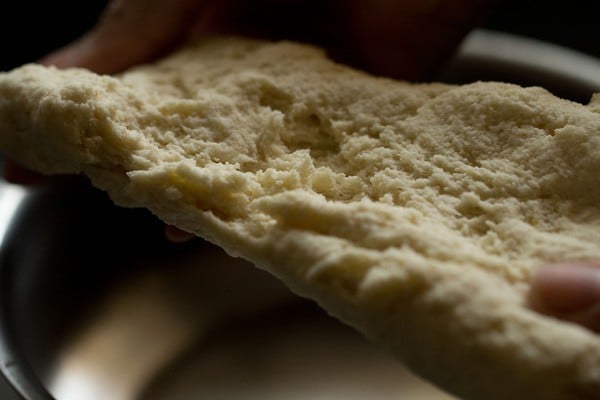
9. Knead to a semi-soft elastic dough.
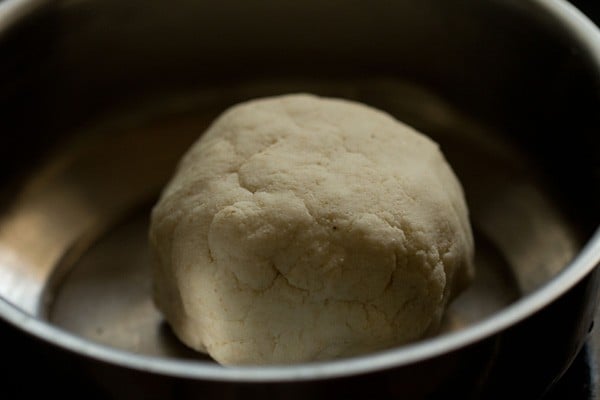
10. Keep the well kneaded dough in a bowl or pan.
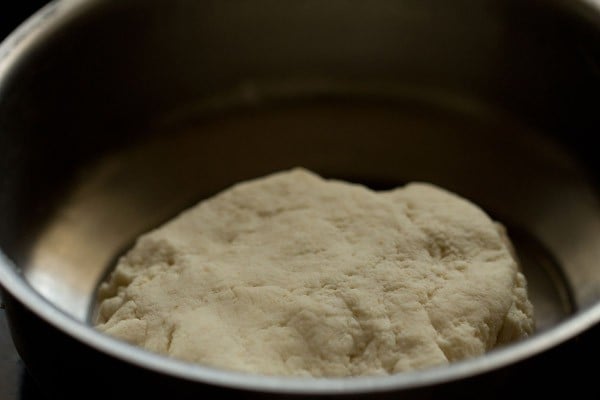
12. Cover with a moist kitchen towel or napkin and allow the dough to rest for 30 minutes.
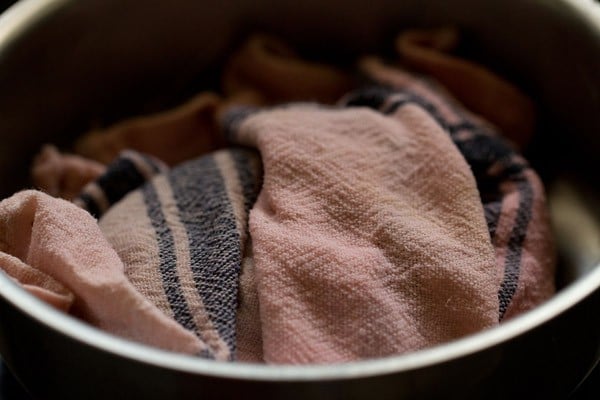
13. Here’s the dough after resting for 30 minutes.
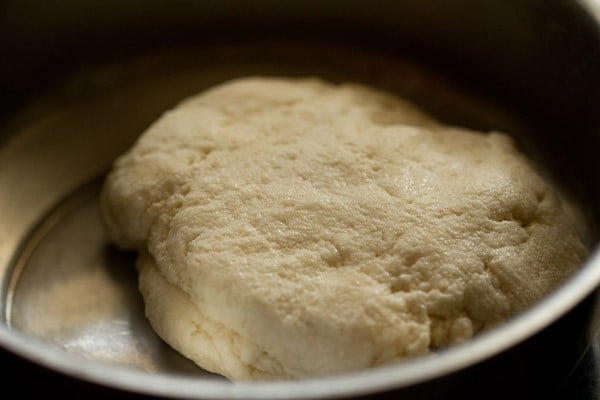
14. Knead the dough again for 2 to 3 minutes.
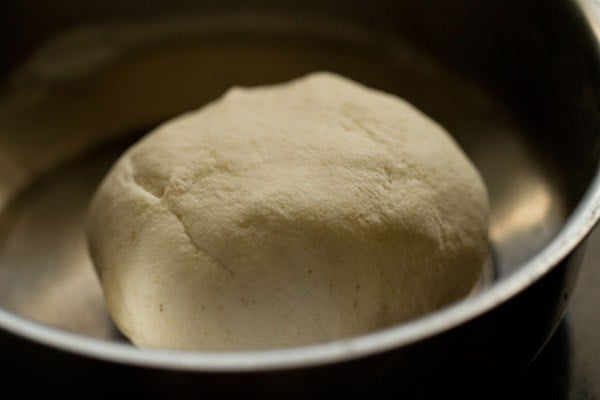
Assemble and Roll
15. Now divide the dough into two or three parts. Take one part on your work surface and begin to roll. Avoid adding any dry flour while kneading. Keep the remaining parts of the dough covered with a moist kitchen towel so that it does not dry out.
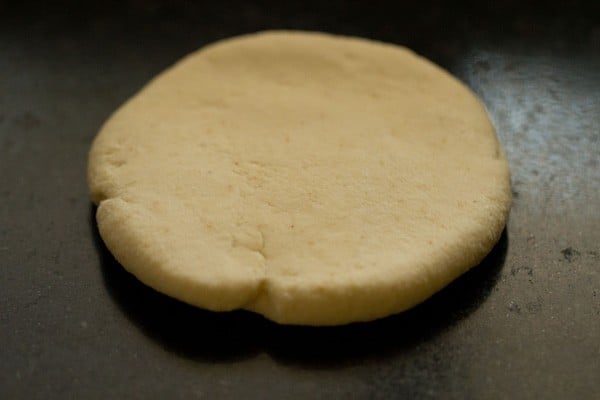
16. Roll to a large round. You see there are no cracks in the rolled dough and the dough has good elasticity. You can flip the entire rolled dough without it breaking or tearing apart.
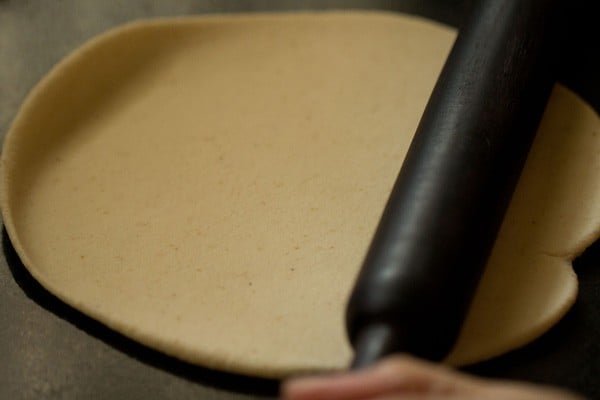
17. Keep on rolling to a thin and even round. The pooris have to be thinly rolled. If not thin, the base becomes thick and remains soft even after frying. If the dough is not rolled evenly, then the pooris won’t puff up.
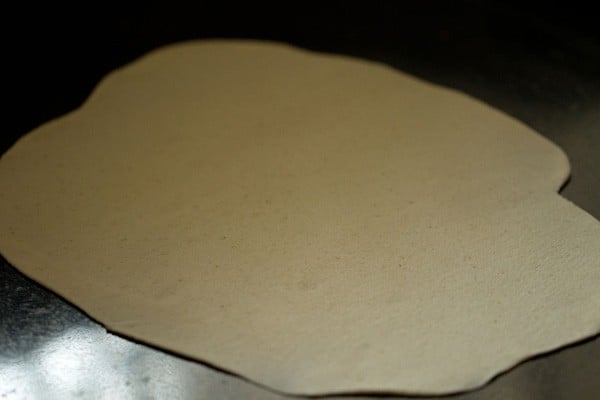
18. With a cookie cutter or a small bowl or a small jar lid, cut small to medium discs from the rolled dough. Using a cookie cutter gives even shape and size to the pooris.
You can also make small balls and roll them with a rolling pin. But then the pooris won’t have an even and uniform shape.
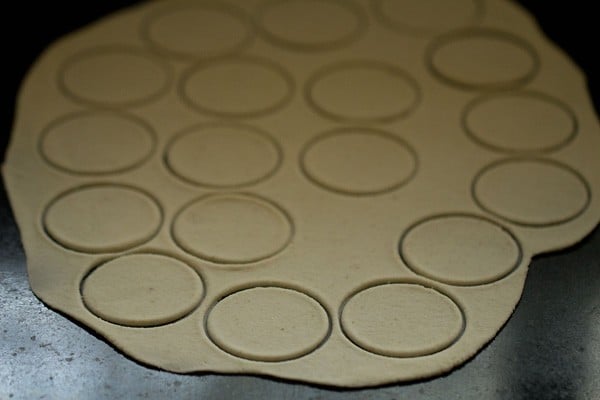
19. Remove the dough edges and place the small roundels on a plate without them touching each other. Keep these pooris covered with a moist kitchen towel.
Collect the dough scrapes and knead them lightly. Again roll this dough and make pooris the same way.
In this way make all the pooris and keep them covered with a moist kitchen towel. You can also roll them and fry simultaneously like I have done.
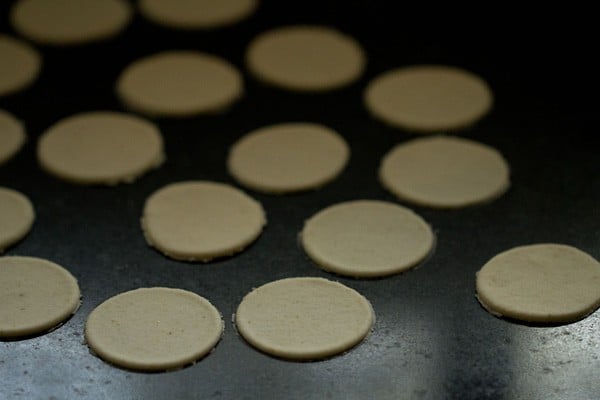
Fry Golgappa Puri
20. Heat oil for deep frying in a kadai or pan. The oil should be medium hot. Add a tiny piece of the dough ball to the hot oil.
If the ball steadily comes up to the surface, the oil is hot and the pooris can be fried now. Don’t fry them at a low temperature of the oil as this will make the puri soggy with oil.
Frying at a high temperature will brown the crust fast but the inside dough will be undercooked and soft.
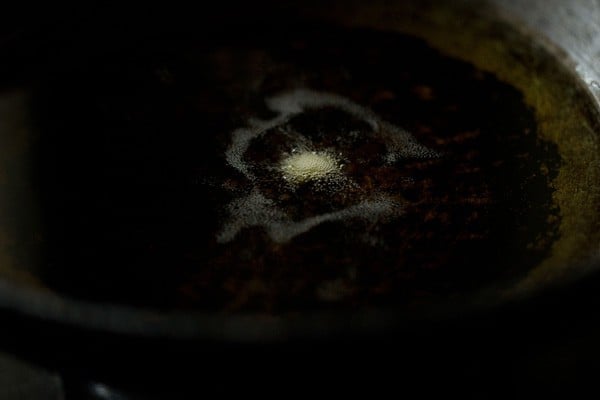
21. Slid a few pooris in the oil. But don’t overcrowd the kadai.
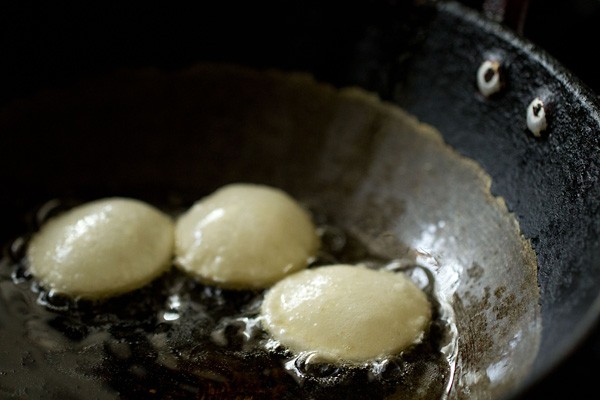
22. They will puff up quickly as soon as you add them to the hot oil. You can fry up to 4 to 8 pieces at a time, depending on the size of your pan. Nudge the pooris with the frying spoon so that they puff up.
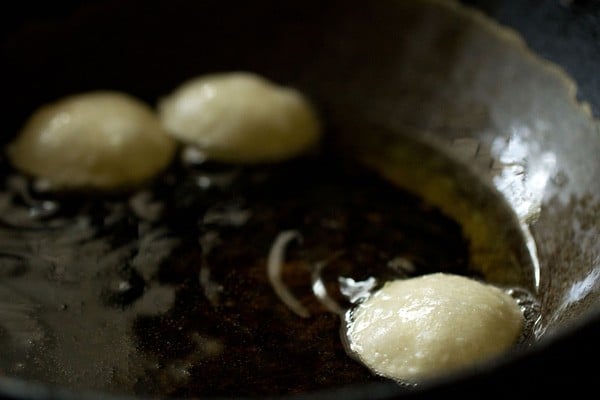
23. With a slotted spoon flip them, once they puff up. Flip a couple of times as needed.
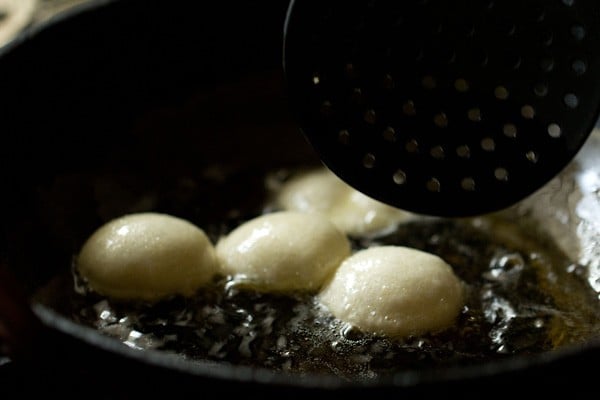
24. Even after oil stops sizzling, continue to fry the pooris till light golden or golden. Even after they become golden, keep them in the oil getting fried for a few seconds, so that they become crisp.
Frying this way, gives a crisp texture to the pooris from outside as well as inside. Otherwise, they may remain soft from the inside and crisp from the outside.
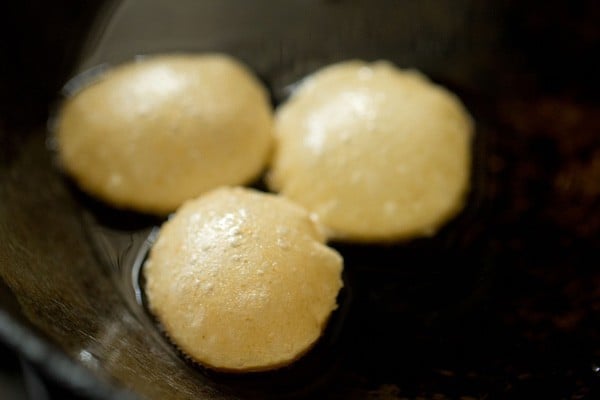
25. Drain puris on kitchen paper towels. There will be a few flat puris too. These you can use to make Sev puri, Bhel puri, chana dal bhel puri or Papdi chaat.
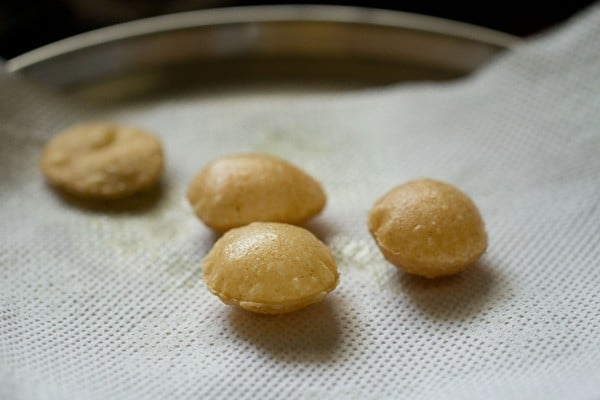
26. Continue to fry the remaining pooris this way in batches.
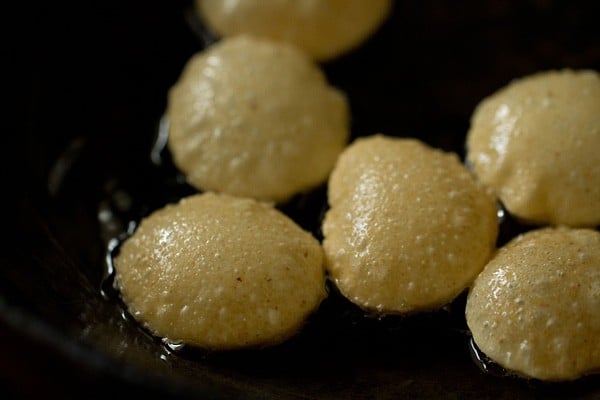
27. Drain puris on paper towels to remove excess oil.
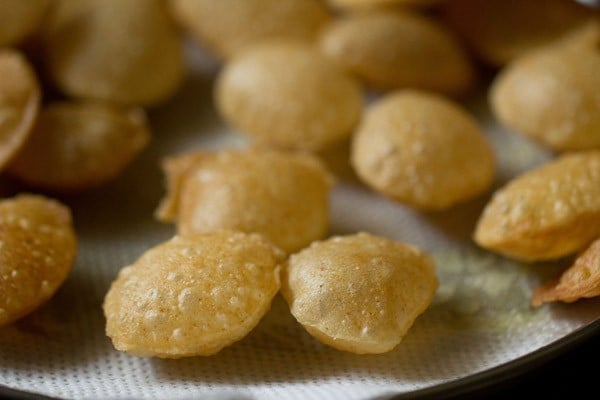
28. Once puris get cooled at room temperature, immediately add them to a jar or box and close the lid tightly.
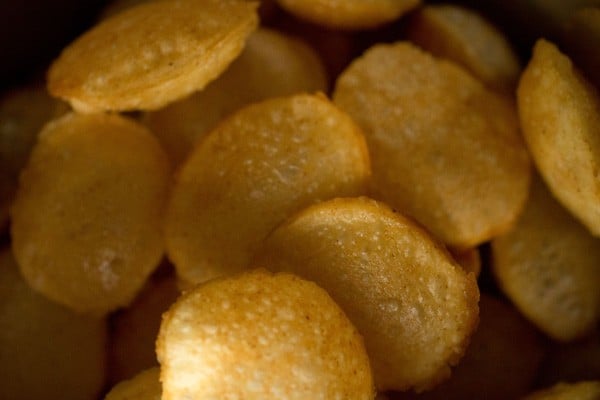
29. A close-up photo showing the crispy texture of the pooris.
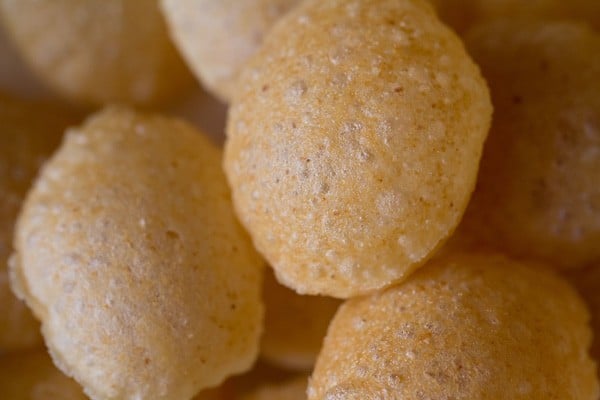
30. Make Pani puri, Dahi puri or ragda puri from these homemade puri or golgappas or puchka.
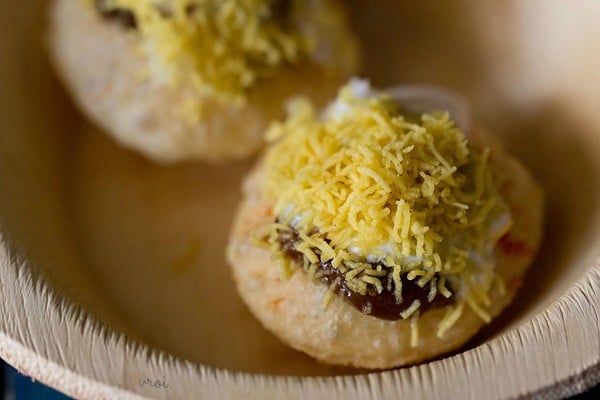
31. You will get 50 to 60 sooji puris from this recipe. They stay crisp and good for a month if stored in an airtight box or jar.
If in case the crispy texture is lost then dry roast the puri in a pan or kadai for some minutes until they become crisp.
Or you can bake them in a preheated oven at 180 degree Celsius for few minutes till they become crisp. But take care that they don’t get too much browned or burnt in the oven. So keep a check when toasting them in the oven.
If you can scale the recipe depending upon the quantity you want to make.
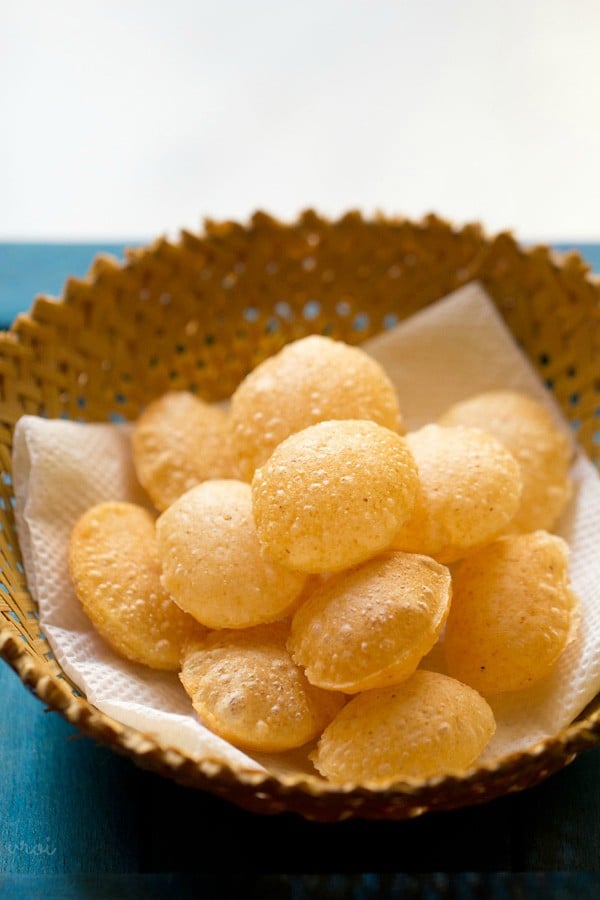
Expert Tips To Make Best Golgappa Puri
- Always cover the dough with a damp cloth even while rolling the puris. If the dough becomes dry, you will not be able to roll the dough easily.
- Ensure that all the rolled puris are covered with a damp cloth. If the puris become dry, then the puris will not puff up.
- These tips comes from experience. Just before frying remove the damp cloth from the puri.
- You could fry 4 to 7 puris at a time depending upon the size of the kadai.
- Do not add oil to the dough while kneading as the suji ke golgappe will become soft later.
- The dough has to semi soft with gluten strands formed in them. There has to be elasticity in the dough. These factors give a crisp puri. The crispness stays even after the pooris are cooled and even later.
- Refined flour or all-purpose flour (maida) is used for binding the dough. Avoid adding more flour to the dough. If the dough is not binding well, then you could add a few teaspoons more of flour. But don’t add too much.
- The puris have to be thin. If you do not roll them thinly, then they won’t puff up well and will remain soft from within.
- Fry the puris in a moderately hot oil. If the oil is not hot enough, the puris will absorb oil and become soaked in oil. Too hot oil, will burn the suji ke golgappe.
Please be sure to rate the recipe in the recipe card or leave a comment below if you have made it. For more vegetarian inspirations, Sign Up for my emails or follow me on Instagram, Youtube, Facebook, Pinterest or Twitter.
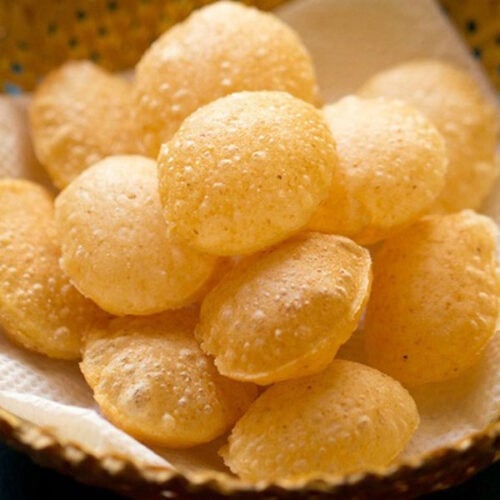
Puri For Pani Puri | Suji Ke Golgappe
Ingredients
- 1 cup sooji (rava or semolina), fine and unroasted – 160 grams
- ⅛ teaspoon baking soda or 3 to 4 pinches
- 1 tablespoon all-purpose flour
- 6 tablespoon water or add as required
- ¼ teaspoon salt or add as required
- 1 teaspoon oil – for the dough
- oil – as required for deep frying
Instructions
Making suji puri dough
- In a mixing bowl, take the fine unroasted sooji or rava or semolina, 1 teaspoon oil, baking soda and salt. With your fingers, mix the oil evenly with the sooji.
- Now add all purpose flour to this mixture.
- Mix again very well so that the all purpose flour is mixed evenly.
- Add 3 tablespoons water first. Mix again. Then add 1 tablespoon water more and begin to knead the dough. Sooji absorbs water while kneading. Add water in parts while kneading.
- Then add 2 tablespoons more of the water and continue to knead. The kneading is very important in getting the perfect texture. The dough is not soft nor too hard.
- If you make the dough soft, then add 1 to 3 teaspoon more of the suji. If the dough looks hard, then add sprinkle some water and continue to knead.
- The suji puri dough should be elastic. Gluten strands need to be formed, which gives a structure and shape to the pooris. The correct texture of the dough, also help in puffing puris and helps in them staying crisp.
- Knead very well. Elasticity helps in rolling the dough without cracks and thinly. When rolling, the dough should roll easily without any cracks. You should be easily able to lift the rolled dough without it tearing or breaking and falling apart.
- Knead to a semi soft elastic dough and keep it in a bowl or pan.
- Cover the dough with a moist kitchen towel or napkin and allow the dough to rest for 30 minutes. You can also keep the dough for an hour.
- After 30 minutes, knead the dough again.
Assembling and Rolling
- Now divide the dough into two or three parts. Take one part on your work surface and begin to roll. Avoid adding any dry flour while kneading. Keep the remaining dough covered with the moist kitchen towel.
- Roll to a large round. There should be no cracks in the rolled dough. You can flip the entire rolled dough without it breaking or tearing apart.
- Keep on rolling to a thin and even round. The puri have to be thinly rolled. If not thin, the base becomes thick and remains soft even after frying. If the dough is not rolled evenly, then the puri won't puff up.
Making Suji Ke Golgappe
- With a cookie cutter or a small bowl, cut small to medium discs from the rolled dough. Using a cookie cutter gives even shape and size to the pooris. You can also make small balls and roll them. But then the puri won't have an even and uniform shape.
- Remove the dough edges and place the small roundels in a plate without them touching each other. Keep these puris covered with a moist kitchen towel.
- Collect the egdes and knead them lightly. Roll the edges too and make puris the same way.
- In this way make all the puris and keep them covered in a moist kitchen towel. You can also roll them and fry simultaneously like I have done.
Frying Suji Puri
- Heat oil for deep frying in a kadai or pan. The oil should be medium hot. Add a tiny piece of the dough ball in the hot oil. If the ball steadily comes up to the surface, the oil is hot and the pooris can be fried now.
- Slid a few pooris in the oil. They will puff up quickly as soon as you add them to the hot oil. You can fry up to 4 to 8 pieces at a time, depending on the size of your pan.
- With a slotted spoon flip them, once they puff up. Even after oil stops sizzling, continue to fry till light golden. Frying this way, gives a crisp texture to the pooris from outside as well as inside. Otherwise, they remain soft from inside and crisp from outside.
- Fry them till they are a light golden or golden.
- Drain fried puri on kitchen paper towels. There will be a few flat puris too. These you can use to make sev puri or papdi chaat. Continue to fry all the pooris this way.
- Drain them on paper towels.
- Once they get cooled at room temperature, immediately add puris to a jar or box and close the lid tightly.
- Make pani puri, dahi puri or ragda puri or puchka from these homemade pooris or golgappas. You will get 50 to 60 pooris from this recipe. They stay crisp and good for a month if stored in an airtight box.
Notes
- Fry the puri at medium temperature of the oil. You can keep the heat to medium to medium-high while frying. Don’t fry at low temperature or high temperature. Regulate the heat as needed.
- Knead the dough very well until you get a semi-soft elastic dough.
- The rava should be fresh and within its shelf period. Use fine textured rava.
- You can easily halve or double the recipe according to your needs.
- Note that the approximate nutrition info is for 1 golgappe ki puri.
Nutrition Info (Approximate Values)
This Suji Ke Golgappe recipe post from the blog archives first published in July 2010 has been republished and updated on 8 January 2022.

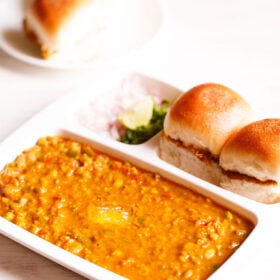
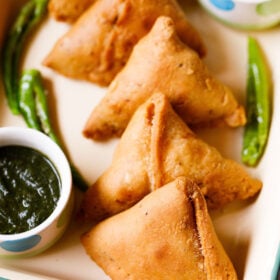
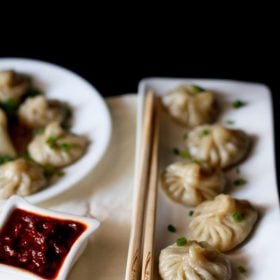








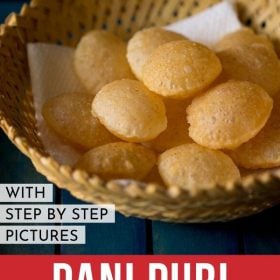
Simple and superb what is dumroot can u pls give details of this recipe.
dumroot is pumpkin halwa. there is another dumroot which is a baked pudding.
I like gol gappy, I have tried them when I was in pakistan, but now I will tried them in washington, thanks to u
surely try selena 🙂 and let us know how were they? and you are welcome.
Thx for the recipe….very helpful n easy…?
welcome saynmika 🙂
Omg!
My mum was craving some snacks today, and I just decided to make gol gappy on a whim, I’m pakistani, our pani recipe differs a lot from yours, and we dont really have hara masala and onions added to our chick peas, but I add them anyway because its just better that way! 😀 so I opened the first tutorial link I could find ( yours ), and just decided to make them, at first I was disappointed because they didn’t swell. But I decided to fry the whole lot anyway, I found that the one’s that came out flat were not moist enough. The one’s right at the end had more water soaked in them and they came out perfect. This was my first try and I managed to pin point my mistakes, and get a perfect puri at the end of it. This tutorial is amazing, I tried to match your actions as much as I could. Thanks so much. You taught me something amazing today! <3
thanks sughra. you are right. its the moisture or water content that helps in puffing the pooris. unlike the regular pooris, which has more of the water content, pani pooris have less of them. too dry the pani poori dough, the pooris won’t puff up. so nice to know you cracked the issue. i must say you are keen observer with logical reasoning abilities. thanks for your sweet comment and good to know that the pooris came out well finally.
Hello,
Thank you so much for the recipe. I have only coarse semolina.can I make with this or should I grind it in mixie?
Thank you in advance.
welcome jayashree. grind it till you get the texture of fine semolina. recipe does not work with coarse semolina.
so many trials ,finally I have done it,thank u so much for such good and easy to understand the steps of this recipe.
welcome priyanka
My mother tried to make the pani puri,but failed every time.This recipe is too good.So my mother helped with this.Thank you.
welcome sayan. glad to know this.
These puris turned perfect. I hv shared your link on a FB food group I am part of. Thanks!
welcome reena. glad to know this.
Dear Dassana,
At what point should the baking soda be added?
I tried making the puris and since the addition of baking soda wasn’t mentioned in the recipe apart from the ingredients section (or I haven’t been able to spot it), I kneaded the dough without adding it. However, I did add baking soda and tried kneading the dough again, but I guess the soda didn’t distribute evenly. So none of the puris puffed up!
However, we did enjoy a nice papdi chaat made from the crisp flat puris 😀
What can I do to ensure the puris puff up the next time?
thanks priyanka for pointing out. baking soda is added in the first step. even without baking soda, the pooris should puff. baking soda additionally helps more in puffing. some recipes i know do not even use baking soda. its just like how we make pooris and in pooris we do not baking soda. but let me tell you the pooris which we get in restaurants have baking soda. thats why they puff up so much unliked homemade pooris. if you add baking soda once the dough is kneaded, they won’t get distributed. at least good to know that you had papdi chaat from the crisp flat puris.
next time try adding some water. semolina absorbs a lot of water. so i think its not the baking soda that is the culprit but less water. depending on the quality of semolina more or less water is required. but just make sure you don’t make the dough soft or sticky.
thank u so much. its lovely tips thank u once again
welcome sweety
Each n every recipe is so simple and yummy thanks for your help to make indian recipes who stay out of india this site is like mother teache her daughter
welcome dina. thanks for sharing your positive feedback.
Hello Dassana,
Thanks so much for the instructions and the lovely pics!
Can you please, please tell me how to make the atta version of the puri? What ratio of gehu ka atta/rava should I use? And are we supposed to put maida in it? I love pani puri with the atta-waala phuchka, but online I only found recipes of suji ones. 🙁
Hope you reply, thanks anyways!
welcome meena. i have never tried making with atta. i always make with sooji. so won’t be able to help you.
you are explainig everything very carefully. thank you for giving tips.
welcome k.praveena
thanks ,nice nd i try
welcome rupam
To make crisp puri, after frying keep them in microwave convection mode 150 degree for 20 to 30 seconds. Observe n don’t let puri blacken. Then store them.
This tip I received in a recently held chat class. Hope it helps though I am yet to try it.
thanks for sharing the tip usha. will help the readers.